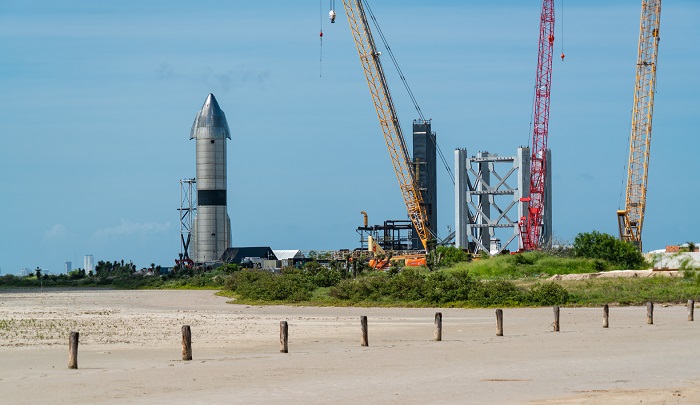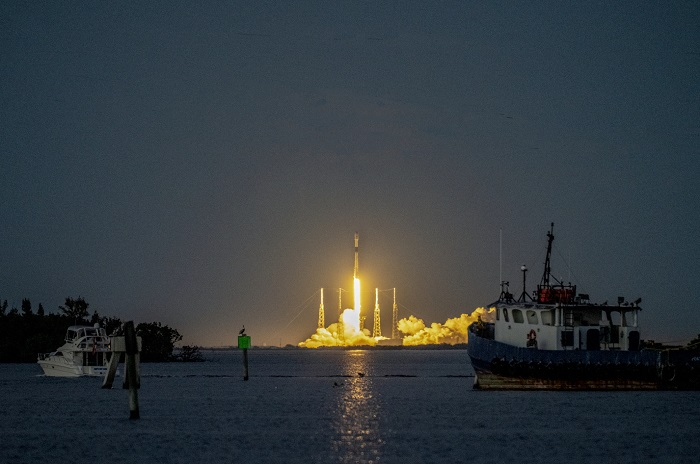headline news online news
By Richard Tribou
Orlando Sentinel
(TNS)
Orlando, Fla. (TNS) — After several days of strong thunderstorms, hail and even a lightning strike at the launchpad, the weather looks to have cleared for SpaceX to retry the launch of its powerful Falcon Heavy rocket from Kennedy Space Center on Sunday evening. online news
Liftoff of the most powerful active rocket on the market from KSC’s Launch Pad 39-A is slated for a 57-minute launch window that runs from 7:29-8:26 p.m. Eastern time with a backup window on Monday. It would be the 21st launch of the year from the Space Coast, with all by one coming from SpaceX.
Its main payload is the ViaSat-3 Americas broadband communications satellite, the first of three planned for the company headed for geostationary orbit. Also flying are the Astranis MicroGEO satellite and Gravity Space’s GS-1 satellite.
Space Launch Delta 45′s weather squadron predicts an 80% chance for good conditions Sunday improving to 95% on Monday.
It’s only the sixth launch ever for the rocket, but second so far in 2023. Among active rockets, its power is only bested by NASA’s Space Launch System that has only flown once and SpaceX’s in-development Starship, which exploded before reaching space during a test launch this month.
It’s essentially three Falcon 9 rockets strapped together with 27 Merlin engines that produce 5.1 million pounds of thrust on liftoff. Past launches have brought out thousands of spectators to the Space Coast.
Unlike previous Falcon Heavy launches, though, SpaceX will not bring any of its three first-stage boosters back for a vertical landing. Normally the two side boosters would attempt returns at nearby Cape Canaveral Space Force Station’s Landing Zones 1 and 2 resulting in sonic booms for the crowds while the center booster would aim for a landing downrange on a droneship,
The required orbital insertion destination for the payloads, though, means SpaceX will need to expend as much fuel as possible, so no sonic booms today. Two of the three have flown previously, with one launching for the eighth time and another for the third. The center stage is the rookie.
Teams attempted a launch on Friday just hours after a successful liftoff of a Falcon 9 from Cape Canaveral, but aborted the countdown with less than a minute before the planned liftoff. Weather had been dicey all day Friday, but looked to have cleared for both launch attempts. This followed Falcon Heavy scrubs on Tuesday and Wednesday because of weather. That included a lightning strike on one of the towers at Pad 39-A, but teams cleared the rocket to proceed with launch.
The company did not give a reason for the abort of Friday’s attempt, though, but said both rocket and payload were good to go for today’s attempt.
headline news online news
The main ViaSat-3 payload is the fist of three planned in a new generation of satellites for the Carslbad, California-based Viasat Inc. that together aim to give nearly global coverage. Deployment won’t occur until 4 1/2 hours after liftoff.
The heart of the satellite has been integrated into a structure built by Boeing Satellite Systems. Called the ViaSat-3 Americas, it will have a coverage area that includes the majority North America including the entirety of the continental U.S., Mexico, Caribbean, Central America and South America.

Plans are for it to be operational in June, after which it’s projected to be able to deliver up to 1 terabit of data per second in the Ka-band of frequencies, the same range that is planned for Amazon’s Project Kuiper when it launches in a few years.
“There are several entrants into this frequency regime,” said Viasat executive Dave Ryan. “Some are there, some are not quite there yet, but it’s a very big marketplace. We believe it definitely can support multiple people in the market.”
The next ViaSat-3 satellite will cover Europe, the Middle East and Africa followed by the final satellite for Asia and the Pacific. Right now all of its existing satellites are in geosynchronous orbit, but it has worked in LEO in the past.
“We believe in the future that a multiorbit strategy is going to be ultimately the best idea because each orbit has its pros and cons,” he said. “Geosynchronous orbit is by far and away the most efficient to deliver broadband capacity to the Earth.”
Each launch could come six to nine months after one another. The next will come on a United Launch Alliance Atlas V rocket, with the final launch provider to be determined.
“Nearly half of the capacity of the ViaSat-3 fleet is designed to be available to areas that are currently unconnected or underserved — and the constellation will have the flexibility to move bandwidth from low-demand areas to high-demand areas,” the company stated in a press release.
SpaceX could launch as many as five Falcon Heavy mission in 2023. After this launch, SpaceX has one planned for the Space Force dubbed USSF-52 expected in the first half of 2023, a private telecom satellite launch for Hughes Network Systems called the Jupiter 3 and the October launch of NASA’s Psyche probe headed the metal-rich asteroid of the same name that orbits the sun beyond Mars.
Its first-ever flight was in 2018, a test launch that sent up Elon Musk’s Tesla roadster into space. SpaceX followed that up with a commercial payload in April 2019, a Department of Defense mission in June 2019, then a three-year drought before knocking out two launches in the last six months.
Excluding Starship, which did not make orbit, SpaceX has now flown 28 missions across its three other launch facilities including eight from Vandenberg Space Force Base. The majority come from KSC and Cape Canaveral.
To date the company has flown 226 successful orbital missions managing 188 booster recoveries allowing for 158 reflights of those boosters.
It managed 61 launches in 2022 and this year could see as many as 100, according to company CEO Elon Musk, with the majority coming from the Space Coast.
———
©2023 Orlando Sentinel. Visit orlandosentinel.com. Distributed by Tribune Content Agency, LLC.
headline news online news


